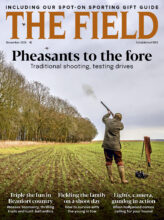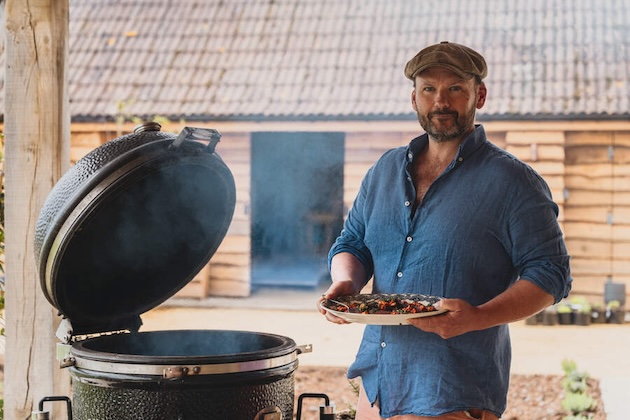Imparting intense flavour to wild meat and game while helping it to last longer, the ancient practice of smoking has evolved into an art form in its own right writes Tom Godber-Ford Moore
How smoking wild meat began
Science is a little undecided but somewhere around two million years ago our hominid ancestors started to harness fire. It wasn’t until about a million years later that we have relatively conclusive evidence that Homo erectus, with a culinary ambition of a magnitude never before seen on Earth, decided to toss their meat on to the fire and make it good.
No doubt lauded among his contemporaries, this early Escoffier must have been the talk of the forest but it wasn’t until around the Palaeolithic era that man learnt to bring the fire into the caves in which they lived. As both fresh and dried meat was hung away from pests in the higher areas of the smoky, chimney-less home, our ancestors began to notice that not only was there an improvement in flavour but the meat lasted longer. When the use of salt for preservation began to spread around 10,000BC to 6,000BC, the amalgamation of these two methods became a relatively fail-safe way to preserve meat and fish for the mid to long term.
Why smoking wild meat is still relevant today
Smoking is still of particular use for wild meat and game because the leaner the meat is the more quickly it spoils. The fat in the likes of pork, beef and lamb acts as a natural preservative, allowing them to be hung for longer periods. I have been smoking game for years, relishing the instant umami and satisfying flavour that comes from woodsmoke.
You can smoke food anywhere from the top of an oven to the riverbank (of course with the proviso that it is done with the utmost caution and only when conditions are appropriate). However, smoking over open fire is not the only method of imparting flavour. There are essentially two forms of smoking wild meat: hot smoking, where the food is cooked during the process, and cold smoking in which you are simply imparting flavour and preservative.
The cure is important, as you are not only seasoning and reducing moisture but also increasing shelf life and adding an all-important tacky surface to the meat to aid the smoke in sticking. It is this smoky layer that will trap the phenolic compounds present in woodsmoke, which are antimicrobial antioxidants inhibiting bacterial growth.
In the modern world of refrigeration, however, it is the smoke’s unique ability to release glutamate – a key amino acid present in the meat protein – that gives that much sought-after umami deliciousness. This process, along with such attributes as the perfect Maillard effect (caramelisation) and the ‘smoke ring’ (a pinking of the meat around the crust or, to use the technical term, ‘bark’) has boomed in popularity in barbecue competitions.
These contests are often fabulously elaborate with expensive equipment. However, smoking meat at home can be quite elementary, and I have put together three recipes (details below) each of which implements a simple, do-it-yourself sort of smoking with minimal kit. There is one thing to note, though: cooking over any form of fire is a skill that is acquired over time, such is the variability of the naked flame. While it is rare that you will produce something completely inedible, it may take several attempts to achieve perfection. For this reason I have made the hot-smoking recipes for two, so you can practise on your tolerant other half before doubling the quantities to show off to others. Thankfully, cold smoking is relatively foolproof.

After adding woodchips to the tin, the writer places the wire rack holding the cured pheasant inside, ready for smoking
Hot smoking
Perhaps one of the most straightforward and safest forms of smoking: find a bag of woodchips, a roasting tray, a wire rack and some tin foil and you’ll be away. Postbrining, the meat will stay marvellously moist and take on a mellow smokiness, partnering nicely with the rich celeriac, tart mustard and sweet apple. Serve the pheasant either hot or cold.

Cold smoking rainbow trout fillets
Cold smoking
With cold smoking it is imperative that you brine or cure the meat beforehand, as you will be smoking the meat or fish at room temperature and need something to prevent bacterial growth during the process. Smoked fish of any variety always feels like a bit of a treat. If you fish even relatively regularly, I would suggest picking up a small cold-smoking cabinet but anything from a cardboard box to an old cupboard can do the job if you just want to give it a try, so long as you have a simple maze smoking box, available separately. I recommend the ProQ.
Plank smoking
A rather fun and incredibly simple means of cooking on the barbecue that gives delicious sweet, smoky and juicy results. Most people own a kettle barbecue of some sort (one with a lid and ideally a temperature reader), while cedar planks are readily available to buy online at around £4 each. This is an excellent choice for last-minute hot smoking, as it needs only a small cure time. The recipe I have given is for venison but it also works wonders with whole pheasant crowns brined in the milk brine described or whole trout or trout sides cured in the same way as the venison. In around two hours you can have home-smoked food even with a gas barbecue, so long as you have a lid.
Recipe for hot smoked pheasant with celeriac rémoulade, quince mustard and apple dressing.





